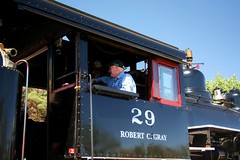
About UsThe Numismatic Bibliomania Society is a non-profit organization promoting numismatic literature. For more information please see our web site at coinbooks.org SubscriptionsThose wishing to become new E-Sylum subscribers (or wishing to Unsubscribe) can go to the following web page link MembershipThere is a membership application available on the web site Membership Application To join, print the application and return it with your check to the address printed on the application. Membership is only $15 to addresses in the U.S., $20 for First Class mail, and $25 elsewhere. For those without web access, write to: David M. Sundman, Secretary/TreasurerNumismatic Bibliomania
Society AsylumFor Asylum mailing address changes and other membership questions, contact David at this email address: dsundman@LittletonCoin.com SubmissionsTo submit items for publication in The E-Sylum, just Reply to this message, or write to the Editor at this address: whomren@coinlibrary.com
BUY THE BOOK BEFORE THE COINYou won't regret it! |
- WAYNE'S WORDS: THE E-SYLUM FEBRUARY 10, 2013
- REPORT ON NBS DONATIONS TO THE ANS LIBRARY
- KOLBE & FANNING EPHEMERA SALE #1 CLOSES FEBRUARY 12
- BOOK REVIEW: ALMANAC OF UNITED STATES COINS, 1ST EDITION
- BOOK REVIEW: PATTERN AND EXPERIMENTAL PIECES OF WW-II
- JOHN HUFFMAN
- HOOPER’S NUMISMATIC FOUNDATION STONES
- NOTES FROM E-SYLUM READERS: FEBRUARY 10, 2013
- ROBERT C. GRAY, COIN SUPPLIES AND THE V&T RAILROAD
- PAPERS OF PROFESSOR J.H. ALEXANDER
- MORE ON GROVER CRISWELL
- SURVEY: WEB RESOURCES MOST USED BY NUMISMATIC WRITERS
- THE KRUPP FIRM AND MINTING
- QUERY: 1959 COIN BUYING PRICES
- FAKE SILVER BARS OFFERED ON EBAY
- THE PCGS COIN SNIFFER
- HARVEY STACK ON MEETING COL. E.H.R. GREEN
- FRANKLIN'S 1776 VISION FOR AMERICA'S GREAT SEAL
- STATE LAWMAKERS PRESSING CASE FOR MAKING OWN MONEY
- AMAZON TO DEBUT "AMAZON COINS"
- BANK NOTE PRINTER DE LA RUE CELEBRATES ITS BICENTENNIAL
- VIDEO: TRIAL OF THE PYX AT LONDON'S GOLDSMITHS’ HALL
- CANADA BEGINS ITS CENT PHASE-OUT
- FEATURED WEB PAGE: THE GREAT SEAL
WAYNE'S WORDS: THE E-SYLUM FEBRUARY 10, 2013

New subscribers this week include Shanna Schmidt, courtesy of Dr. Ute Wartenberg Kagan, Finn Jørgensen of Denmark, Charalambos (Babis) Vogias, and Jeff Benjamin. Welcome aboard! We have 1,624 email subscribers, plus 210 followers on Facebook.
A number of our readers in the Northeastern U.S. have been dealing with a major blizzard this weekend. Dick Johnson in Connecticut writes:
We had 28 inches of snow with drifts up to 4 and 5 feet. Both doors were blocked by snow drifts, and we had to exit through the garage door. A snow plow has done our driveway twice and still must come back to eliminate some more snow drifts. Thank goodness for TV, computers and books to read. We have stayed indoors for two days, maybe another tomorrow. No loss of power.
Stay safe and warm, everyone. Luckily we've been spared here in Northern Virginia. It was cold but clear and sunny today, although the winds knocked some shingles off our roof Friday night.
This week we open with a report on NBS donations to the ANS library and a reminder about the closing date of the Kolbe-Fanning Ephemera Sale #1.
Other topics include an early ANA offprint, fake silver bars, the Prophylactic Tooth Brush Company, John Huffman, J.H. Alexander, Grover Criswell, Robert C. Gray and Ben Franklin's original design concept for the Great Seal of the United States.
To learn more about the PCGS Coin Sniffer, the Friedrich Krupp firm, Amazon Coins, the keys to Fort Knox, a descent into “la-la land", and Col. E.H.R. Green's coin-buying habit, read on. Have a great week, everyone!
Wayne Homren
Editor, The E-Sylum
REPORT ON NBS DONATIONS TO THE ANS LIBRARY
American Numismatic Society Librarian Elizabeth Hahn writes:
"I would like to take a moment to reiterate my gratitude to the Numismatic Bibliomania Society for the continuing support of the ANS Library. At the last NBS meeting, which took place at the ANA in Philadelphia in August 2012, the NBS generously donated $5,000 to the ANS Library (mentioned in the 2012 Philadelphia NBS meetings report) and since then we have put this donation to great use. In November 2012, we hired library cataloger Katie Rissetto, who is now working full-time in the ANS Library. Katie has her Master’s in Library Science degree with a concentration in rare books and special collections and she is an efficient cataloger and has adapted quickly to working at the ANS.
Already we have discovered some previously un-cataloged items in the rare book room that now appear in DONUM. I often use these items as discussion points for my ANS Magazine library column, and have recently submitted an article for future Asylum publication consideration about one such recent discovery. I look forward to continuing to learn from the NBS community and share our own discoveries here in the ANS Library!"
To read the earlier E-Sylum article, see: REPORT ON THE 2012 PHILADELPHIA CONVENTION NBS MEETINGS (/www.coinbooks.org/esylum_v15n34a02.html)
KOLBE & FANNING EPHEMERA SALE #1 CLOSES FEBRUARY 12
 Kolbe & Fanning wish to remind our customers that our first internet sale featuring numismatic ephemera acquired over several decades by the firm’s founder, George Kolbe, will close this Tuesday, February 12. The sale includes a diverse offering of numismatic memorabilia, letters, circulars, photos, promotional materials and other miscellanea. The online catalogue is available on our website at www.numislit.com. Bids will be accepted by phone, voicemail, email or fax.
Kolbe & Fanning wish to remind our customers that our first internet sale featuring numismatic ephemera acquired over several decades by the firm’s founder, George Kolbe, will close this Tuesday, February 12. The sale includes a diverse offering of numismatic memorabilia, letters, circulars, photos, promotional materials and other miscellanea. The online catalogue is available on our website at www.numislit.com. Bids will be accepted by phone, voicemail, email or fax.
Phone bids will be accepted until 6 p.m. Eastern Time at (614) 414-0855.
Voicemail bids will be accepted until midnight at (614) 414-0855.
Email bids will be accepted until midnight at df@numislit.com.
Fax bids will be accepted until midnight at (614) 414-0860.
Response to this first sale has been enthusiastic, and we look forward to hearing from you.
To read the earlier E-Sylum article, see: KOLBE & FANNING GEORGE KOLBE EPHEMERA SALE #1 (www.coinbooks.org/esylum_v16n04a04.html)
BOOK REVIEW: ALMANAC OF UNITED STATES COINS, 1ST EDITION
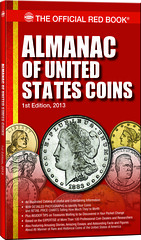 I bought a copy of the newly released Almanac of United States Coins expecting it to be a somewhat more informative version of the yearly Guidebook of United States Coins (The Red Book) from the same publisher. Looking back at the announcement in the last issue of The E-Sylum, I realize now that that expectation was unwarranted, and I should have paid more attention to that description.
I bought a copy of the newly released Almanac of United States Coins expecting it to be a somewhat more informative version of the yearly Guidebook of United States Coins (The Red Book) from the same publisher. Looking back at the announcement in the last issue of The E-Sylum, I realize now that that expectation was unwarranted, and I should have paid more attention to that description.
This is a book that is a good introduction to the hobby for beginners, but I don’t really see that established numismatists can gain anything by buying it, and I would recommend the Red Book over it even for beginners. For only a couple dollars more, the Red Book gives far more information in far greater detail. The introductory essays in the Red Book give a comprehensive overview of coinage in the United States starting in colonial times, and of course, the date and price listings of the individual coins series is unparalleled. In short, skip the “Red Book Lite.” Buy the real thing.
I asked Dennis Tucker of Whitman Publishing for a response, and his discussion of the book is below. Thanks! -Editor
Thanks for the opportunity to respond regarding the Almanac of United States Coins.
Mr. Bishop is right about the Red Book being the hobby’s “go-to” book for date-and-price listings --- it covers 7,000-plus coins, tokens, coppers, Proof sets, and similar numismatic collectibles. The Almanac of United States Coins doesn’t try to match that level of coin-by-coin detail. It does provide pricing charts for U.S. type coins (i.e., pricing across eight grade levels for the most common date within each series), along with narrative discussion of pricing you’ll see in the marketplace, descriptions of key and semi-key dates as well as popular die varieties, and details of significant auction results. This depth of narrative isn’t possible in the Red Book. Even at a hefty 448 pages, the Red Book is bursting at the seams --- it includes more than 32,000 prices! --- and doesn’t have as much room as the Almanac for stories about famous coins, diagnostic explanations of individual die varieties, and other historical context.
Here are a few examples.
• The Red Book tells you how much a coin dealer would charge you, retail, for a single 1958 Wheat cent that he stapled into a 2x2 holder and set in his shop display case for sale. The Almanac tells you
“Common-date Wheat cents can be bought in large quantities. In bulk the coins can retail for $0.03 to $0.05 apiece (between $150 and $250 for a 5,000-coin bag, although shipping costs can be an additional factor), with typical grades being VG or Fine up to lower-end Mint State. Most rolls and bags of the coins have been searched by dealers or collectors over the years, with older and scarcer dates and varieties picked out --- although sometimes treasures can still be found. Here are some coins to look for. . . .”
That kind of real-life advice and insight is invaluable for new collectors. It makes the Almanac an ideal companion to the Red Book, not a substitute for it, not a competitor, and not a “lite” version.
• The Red Book tells you the value of 1875 Indian Head cents in nine different grades, including Proof. The Almanac tells you the story behind the 1875 “Dot Reverse” variety --- a story involving a dishonest Philadelphia Mint employee and the remarkable trick his bosses played to catch him in an act of theft.
• The Red Book tells you the values of your Eisenhower dollars, coin by coin. The Almanac tells you about the Big Sky Hoard of more than 220,000 Ikes found in a Montana family’s bank vault in 2011, and how they came to be there.
• The Red Book gives you the value of every date and mintmark of U.S. dollar minted from 1794 to date, in multiple grades. The Almanac explains how speculators in the late 1700s took American silver dollars down to the Caribbean islands, exchanged them for heavier Spanish milled dollars, and then returned with the latter to Philadelphia to make a profit at the Mint’s expense --- and the “butterfly effect” this activity has had on the rare-coin marketplace 200 years later.
The Almanac of United States Coins does provide an impressive amount of numismatic knowledge in its 192 pages, and I do believe intermediate to advanced collectors will find it a “good read” just as newcomers find it instructive and educational. The biggest long-term benefit the Almanac will have for the hobby is to introduce casual collectors (State quarter enthusiasts curious to go deeper, folks who have found Grandpa’s cigar box full of old U.S. coins, and other “passersby”) to the wonderful world of coin collecting --- and, we hope, get them happily hooked.
The book will be distributed through mass-market big-box stores, bringing the hobby to tens of thousands of potential new collectors. The Almanac will help them identify what their coins are, and give them ballpark values, while entertaining them with interesting sidebars. If the coin bug bites --- if they’re fascinated by the stories, colorful images, and anecdotes --- then they can move on to the Red Book, the Professional Edition Red Book, and the Cherrypickers’ Guide, join the American Numismatic Association and a local coin club, visit their local coin shop, start attending shows and conventions, and make numismatics a lifelong hobby.
To read the earlier E-Sylum article, see: NEW BOOK: ALMANAC OF UNITED STATES COINS (www.coinbooks.org/esylum_v16n05a06.html)
BOOK REVIEW: PATTERN AND EXPERIMENTAL PIECES OF WW-II
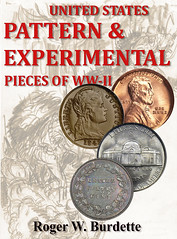 I'm happy to report I have in hand a copy of Roger Burdette's new book on the Pattern and Experimental Pieces of WWII. I got it directly from him in a clandestine after-work handoff in a restaurant parking lot.
I'm happy to report I have in hand a copy of Roger Burdette's new book on the Pattern and Experimental Pieces of WWII. I got it directly from him in a clandestine after-work handoff in a restaurant parking lot.
I'm no expert in WWII pattern coins, but Roger certainly is - he's clearly done his homework on this book, to the benefit of the rest of us in the hobby. Most of what readers will find in this book is new information, the product of Roger's many hours of research in national, local and corporate archives. He even placed advertisements in communities where workers who produced the patterns would have lived. While Roger is the first to admit that this first edition is an incomplete work in progress, it clearly stands head and shoulders above what little has been published before on this narrow topic.
The 188-page softbound book was produced in a limited edition of 500 copies. It opens with Roger's Introduction followed by the extensive Acknowledgements, which include nods to the major auction houses, dealers, collectors and researchers who assisted his study, including a host of E-Sylum regulars including Augsburger, Bowers, Bressett, Ginsburg, Julian, Kraljevich, Lange, Lustig, Teichman and Orosz.
The first chapter provides an overview of the experimental coins, Mint processes and procedures, and the corporate participants in the study. Numismatists will be familiar with the names of Mint Director Nellie Tayloe Ross and engraver John Sinnock. Other names, such as the Patent Button Company of Knoxville, TN will be new to many readers.
One fact that comes up early in the book is that the first wartime material to be removed from U.S. coinage was in fact tin. Some 93% of all 1942-D cents were made with only the tiniest trace of tin in a nod to the prevailing coinage laws which specified tin, but didn't specify an amount. So how can one tell the difference? The remaining 7% of 1942-D cents were made from existing stocks of planchets on hand before tin was removed from the mix.
Roger has identified three different reverse dies for the experimental plastic cents of 1942. Of course, mint-produced coin dies could not be used directly, but apparently mint officials were clueless. Coin dies could not be used in either injection or compression molding: "they were the wrong size and lacked heating channels, sprue and runner connections necessary for molding. All plastics companies had to remake the mint dies so they would work in their molding machines" (p19).
Quite a number of contractors large and small were involved with the experiments. In addition to the Patent Button Company, Westinghouse, DuPont, General Electric, Monsanto, the Auburn Button Works and the Prophylactic Tooth Brush Company were among the contractors. The materials involved would be even less familiar to numismatists, including "Tenite", "Fibestos" and "Plastacele".
Chapter Two is an extensive compilation of information about the companies involved in the experiments, with significant contributors separated from the rest of the pack. Included are quotes and excerpts from their correspondence with the Mint. All references are clearly footnoted.
Chapter Three is primarily a catalog of experimental cents, but it is prefaced with a discussion of the general characteristics of the pieces, which is important to the catalog's organization.
Most of the images are photos of actual specimens. Other entries have no image. But for some, Roger has created realistic artist recreations based on the descriptions found in his research. One such recreation is this "War Series" cent shown on the book's cover.
Chapter Four addresses all of the replacement materials considered for the cent, while Chapter Five looks at the 1942 experimental five cent pieces. The Mint handled experiments for the this denomination itself, so there is no outside documentation to be had. And given the rush of war, apparently not much internal documentation was generated either. The first experiments were in November 1941, when eight coins were produced on stainless steel planchets. Other experiments with various metals ultimately resulting in a decision to use the silver alloy known today for the "War Nickels".
The book is completed with a short Chapter Six on the Sources of Experimental and Pattern Pieces, eight appendices and a bibliography. The Appendices include a good deal of interesting and useful material, such as a complete National Bureau of Standards report on the plastic tokens, a copy of the December 18, 1942 Public Law Authorizing Changes to the Minor Coins, and a very useful table and technique for identifying the precise color of a plastic piece.
So what happened to the pattern and experimental pieces that were made? Roger's review of the records shows that instructions to return and destroy the pieces were followed incompletely if at all.
"The outside contractors paid little attention to tracking experimental pieces. They were after all, not coins and had no statement of value. Samples were forwarded to the Mint, but most others came to rest in a trash dump or incinerator. Employees likely took home samples to show the kids and from there, examples could have ended up in cigar boxes, taped in photo albums, or used as game counters or even buttons." (p115)
Despite this "leakage" from the Mint, very few of most types of pieces were made in the first place, and most of those were later destroyed, including the stainless steel nickels mentioned above. This makes for some great rarities. The population table on p170 shows that many are unknown, many others may be unique, and none has an estimate population of more than 50 pieces.
Since few of us are likely to ever own one of these rare experimental pieces, why buy the book? Well, few of us will own an 1804 dollar either, but that doesn't keep me from owning multiple books on them. This is pure numismatic history, and a key piece of the puzzle of 20th century U.S. coinage. I highly recommend Roger's book to E-Sylum readers, who include, as I often note, "numismatic bibliophiles, researchers, writers, and just plain collectors." See the earlier E-Sylum article for price and ordering information.
To read the earlier E-Sylum article, see: NEW BOOK: PATTERN AND EXPERIMENTAL PIECES OF WW-II (www.coinbooks.org/esylum_v16n05a05.html)
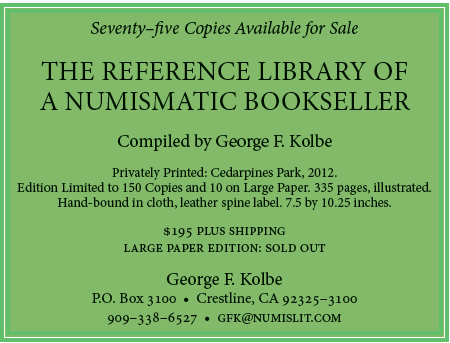
JOHN HUFFMAN
From the Montgomery County (Maryland) Coin Club web site:
It is with great sadness that the Montgomery County Coin Club mourns the passing of John Huffman on Thursday, January 31, 2013. Huffman had been a member of MCCC since the 1970s and has served on the Board as well as being elected twice to be the club’s vice president.
John’s obituary was printed in the February 3, 2013 edition of The Washington Post. The Montgomery County Coin Club sends our collective condolences to John’s family and friends.
Well known for his interest in silver coins, John also collected ancients and coins and other items related to R.L. Stevenson’sTreasure Island.
To read the complete article, see: Passing of John Huffman (mdstatenumisassn.org/MCCC/2013/02/03/passing-of-john-huffman/)
Dick Ennis of Fairfax, Virginia writes (on the Washington Post obituary page):
John was known for his diverse interests: coin collecting, history, stock and securities valuation, distilled spirits, and one of the largest collections of Dracula memorabilia and books in the country. John enjoyed sharing his knowledge of the various subjects.
In addition to contributions to St. Bernadette parish and school, John was generous in sharing his resources with relatives and others. During the last two years, he made multiple trips to New York to help the widow of a fellow coin collector organize and realize the value of his coin catalogs and other books on coins.
Joe Makurath of Alexandria, Virginia writes (on the Washington Post obituary page):
John regularly stopped by my office whenever he acquired new coins. He always entertained with his knowledge of the history connected with each acquisition.
To read the Washington Post obituary, see:
JOHN P. HUFFMAN
(www.legacy.com/obituaries/washingtonpost/obituary.aspx?
n=john-p-huffman&pid=162803694)
Scott Miller writes:
I probably knew John for 30 years or more, having met him through our mutual friend, Gordon Frost. I believe he had a fairly large library; a long time non-numismatic interest included books about Dracula. He was a life fellow of the ANS, with numismatic interests in Ireland, sunken treasure, as well as some general areas. He liked to pass around relatively current but unusual items to friends and co-workers at IRS (he retired a few years ago), such as Eisenhower dollars, $2 bills, &c.
Howard Daniel writes:
John and I go back about 10+ years. We probably met the first time at one of my first NBS meetings at an ANA. He and I like to joke a lot and we quickly became friends. He recently retired as one of the top lawyers in the IRS. He really did not have much time to enjoy himself after retirement. After I return to the USA, I will find his grave and leave a coin on it. I will miss him!
I know John was a collector of ancient coins. Howard shared with me his last email exchange with John, where he wrote that he'd recently acquired "a NW India standardized weight bar small "bar" silver from the time period of Persian domination (500-300 BC) and a Egypt silver tetradrachma of Cleo VII & Ptolemy XV (44-31BC), only son of Big Julie the Roman."
HOOPER’S NUMISMATIC FOUNDATION STONES
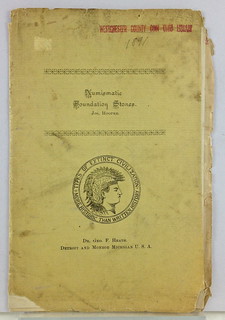 Hooper’s Rare Numismatic Foundation Stones, Printed by Dr. Heath
Hooper’s Rare Numismatic Foundation Stones, Printed by Dr. Heath
1052 Hooper, Jos. NUMISMATIC FOUNDATION STONES. Detroit and Monroe: Dr. Geo. F. Heath, circa late 1892 / early 1893. 8vo, original printed yellow wraps. (4), 19, (1) pages; numismatic woodcut illustrations. Contents loose and unsewn, as issued. Ex Westchester County Coin Club Library, with their stamp on the front cover and on the first three leaves. Wraps dusty and a bit worn. Very good. (400.00)
Rare: the only other copy we have sold in the last 25 years was in a bound set of the first six volumes of The Numismatist. This work originally appeared serially in The Numismatist from October 1891 to December 1892. Accompanied here by its own set of printed pale yellow wrappers, the type, though much of it does not appear to have been reset, has been rearranged and edited, including at least one typographical correction, and includes the addition of several well-placed numismatic woodcuts. The pagination comprises a blank leaf, the title leaf, which includes a woodcut numismatic medallion (as does the front wrapper), followed by 19 re-numbered and re-captioned printed pages, last page blank. The first page of text features the printed masthead of the October 1891 issue, although this first Numismatist reprint appears to have been published in late 1892 or early 1893.
NOTES FROM E-SYLUM READERS: FEBRUARY 10, 2013
More on the 'First' 1794 Dollar
Regarding the recently sold 1794 dollar, Bill Eckberg writes:
I absolutely agree with Dick Doty on this coin. Ever since I first heard years ago that it "was", which they later hedged to "might have been" the first US dollar struck, the fact that it has adjustment marks has always meant to me that this coin could not have meant anything special to the US Mint at the time. If there was any hoopla at the time of striking - and I am not aware of any evidence that there was - they would surely have selected a better planchet for the BIG EVENT.
To read the earlier E-Sylum article, see: ON THE 'FIRST' 1794 DOLLAR (www.coinbooks.org/esylum_v16n05a14.html)
More on the Travels of the Liberty Bell
Russ Sears writes:
I would like to share the attached about the travels of the Liberty Bell. The reverse of the souvenir card indicates quite a bit of traveling by the bell. The pinbacks were souvenirs of visitors at the St. Louis World's Fair of 1904 and the Panama-Pacific International Exhibition of 1915 in San Francisco.

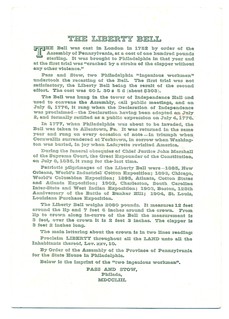
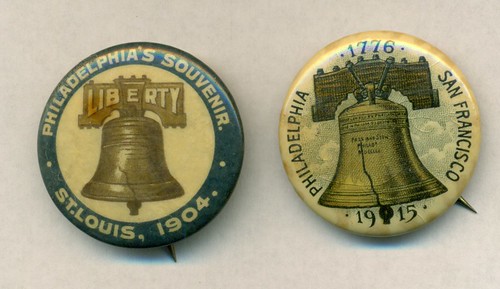
To read the earlier E-Sylum article, see: NOTES FROM E-SYLUM READERS: FEBRUARY 3, 2013: Postcard of the Traveling Liberty Bell (www.coinbooks.org/esylum_v16n05a18.html)
ROBERT C. GRAY, COIN SUPPLIES AND THE V&T RAILROAD
It is interesting where things lead...
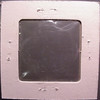 Happily I am now in possession of 5 boxes of the large square-window 2x2s. Duane Feisel sold them to me - two other E-Sylum readers responded that they also had some.
Happily I am now in possession of 5 boxes of the large square-window 2x2s. Duane Feisel sold them to me - two other E-Sylum readers responded that they also had some.
One of the boxes Duane sent had a "U-Do-It" sticker on the end. Also on the sticker was "Robert C. Gray Coin and Stamp Supplies". A Google search shows that the Robert C. Gray Company is still active in Carson City, NV. Since I don't need any more holders, I'll just file that info away. But additional Google searching found the following:

I don't know whether the gent in the red shirt in the third photo is Gray or just a passer-by. I do suspect that Robert C. Gray is the only numismatist to have a steam locomotive named after him...
To read the complete article, see: Engine #29 – The Robert C. Gray (aroundcarson.com/2009/08/15/engine_29_the_robert_c_gray/)
Duane Feisel writes:
Gray was a coin dealer in Oakland, CA at one time, and then moved to Nevada. To tell the truth I didn’t know he had gotten into coin holders! I met Robert C. Gray many years ago when I had tokens made in the 1970’s for the Virginia & Truckee Railroad in Virginia City NV. When I delivered the tokens I made a trip on the train, riding in the engine cab with Bob and the engineer. I didn’t know what his exact involvement was, but found this on the Internet:
Hungry for details, I picked up the newly published “Official Guidebook of the Virginia & Truckee Railroad,” by Stephen E. Drew, in the gift shop. The cashier noted that Robert C. Gray — who is featured in a 1938 photograph in the book — would be riding with us. I took note and kept on the lookout for him; later I found out that Gray was, in fact, a key figure in reviving the Virginia & Truckee.
“Bob Gray is a longtime rail fan. He grew up in the ’30s with a deep interest in railroads,” said Kyle Wyatt, curator for history and technology at the California State Railroad Museum. “He had been one of the people who had ridden on one of the last excursions from Carson City to Virginia City before that line was shut down in 1938.
“In the early 1970s, he found himself in a position where was able to restart the V&T Railroad,” Wyatt added.
To read the earlier E-Sylum article, see: NOTES FROM E-SYLUM READERS: FEBRUARY 3, 2013: 2x2 holder with the square window sought (www.coinbooks.org/esylum_v16n05a18.html)
THE BOOK BAZARRE
PAPERS OF PROFESSOR J.H. ALEXANDER
Ed Hohertz writes:
The article on the proof gold coin set being sold from the Royal Mint Collection had me search the library of the local Western Reserve Historical Society (Cleveland, Ohio). This may be the same Alexander, but tells us nothing of his interests in numismatics.
Index to the Calendar of Maryland state-papers, comp. under direction of John Henry Alexander.
by Alexander, J. H. (John Henry), 1812-1867, ed.
Baltimore, J. S. Waters, 1861. Subjects • Archives -- Maryland.
Description: xiv p., 1 l., 66 p. 24 cm.
OCLC #: ocm07393523
Notes: Index to the first volume of a manuscript calendar of Maryland documentary material, covering in general the period, 1637-1702.
Add Title: Calendar of Maryland state-papers, Index to.
LCCN: 01007121
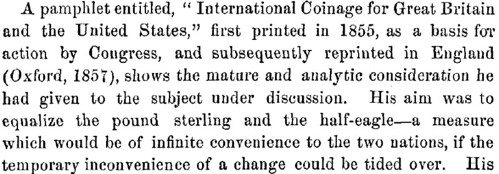
In 1857 Dr. Alexander went to Europe representing the U.S. government in drumming up interest for a Unification of Coinage. He was unsuccessful. According to the pamphlet, Alexander was about to be appointed Director of the Mint in 1867, but he died before that could happen.
To read the complete pamphlet, see: BIOGRAPHICAL MEMOIR OF JOHN H. ALEXANDER. (www.nasonline.org/publications/biographical-memoirs/memoir-pdfs/alexander-john.pdf)
To read the earlier E-Sylum article, see: MORTON & EDEN TO SELL DUPLICATE 1859 U.S. PROOF SET (www.coinbooks.org/esylum_v16n05a26.html)
MORE ON GROVER CRISWELL
Ron Guth writes:
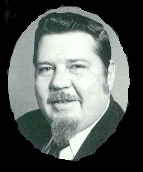 The identification of Grover Criswell brings back many memories. My family moved from Manchester, New Hampshire to St. Petersburg, Florida in 1960, back when it was a sleepy town with a few hotels/motels on the beach and just about nothing else (condos did not exist back then, just tiny beach cottages). Pass-A-Grille Beach was one of our favorite haunts and I can remember driving by Grover's place on several occasions as we headed to the beach.
The identification of Grover Criswell brings back many memories. My family moved from Manchester, New Hampshire to St. Petersburg, Florida in 1960, back when it was a sleepy town with a few hotels/motels on the beach and just about nothing else (condos did not exist back then, just tiny beach cottages). Pass-A-Grille Beach was one of our favorite haunts and I can remember driving by Grover's place on several occasions as we headed to the beach.
I got to know him well in both of our later years when he was active in the Florida United Numismatists. I knew him as "Colonel" Criswell and every time we met, he would have a new off-color joke for me. Coincidentally, my wife, youngest daughter and I just vacationed in Sunset Beach, FL, right before the F.U.N. show. Sunset Beach is just north of St. Pete Beach (where Grover's business was located), which is just north of Pass-A-Grille Beach.
Here's a link to a People magazine article about Grover: "the richest man in the world."
I always have at least $25 million to $30 million lying around," says Grover Cleveland Criswell, pausing to light a stogie with a $20 bill. "I definitely am the richest man in the world." The richest, that is, in Confederate money. Criswell, 44, is the most active dealer in the world in the paper currency issued by Southern states during the Civil War.
Monopoly money it isn't. Although most Confederate notes have little value, there are exceptions. The $5 bill with slaves loading cotton in the lower left corner and an Indian princess in the upper right is priced as high as $20,000, depending upon condition. Collectors' demand for such keepsakes earns Criswell about $100,000 a year and has made him a millionaire.
Born in Oak Park, Ill., Criswell began squirreling away bottle caps, match covers, coins and stamps when he was 6. One day his father gave him some Confederate money that had belonged to Criswell's great-uncles, both Civil War veterans. "At the time," he recalls, "Dad thought it was worthless. It turned out the bills were much more valuable than the coins he kept for himself."
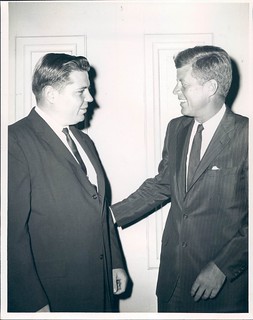 Criswell later attended the Florida Military Academy and then the Citadel in Charleston, S.C., where he majored in history and met his wife, Nellie. He continued trading in old currency through two years in the Air Force and two years as mayor of St. Petersburg Beach. An active supporter of John F. Kennedy, he turned down an appointment in that Administration to make an unsuccessful bid for Congress.
Criswell later attended the Florida Military Academy and then the Citadel in Charleston, S.C., where he majored in history and met his wife, Nellie. He continued trading in old currency through two years in the Air Force and two years as mayor of St. Petersburg Beach. An active supporter of John F. Kennedy, he turned down an appointment in that Administration to make an unsuccessful bid for Congress.
Criswell eventually opened a money museum in St. Petersburg, but moved to Salt Springs, Fla. after thieves cut a hole in the roof and took off with $298,000 worth of coins and paper. Criswell, who packs a .38 on the road and carries his merchandise in a nondescript gray briefcase, sometimes thinks back to the job he was offered by JFK—director of the U.S. Mint. Laughs the money merchant: "I sure would have liked those keys to Fort Knox!"
To read the complete article, see: Money Merchant Grover Criswell Ain't Just Whistlin' Dixie (www.people.com/people/archive/article/0,,20072403,00.html)
To read the earlier E-Sylum article, see: GEORGE WALTON PHOTO IDENTIFICATION (www.coinbooks.org/esylum_v16n05a16.html)
SURVEY: WEB RESOURCES MOST USED BY NUMISMATIC WRITERS
As a numismatic writer, what are the websites you use most often for researching data, fact checking or gathering background information? Curious minds -- that is, other numismatic writers -- would like to know. Are you using the full spectrum of websites available in your numismatic writing?
I would like to see a survey of E-Sylum readers, who are, for the most part, the major writers in the field. We are blessed with a large number of serious websites compiled by competent writers who have provided these for our use. But are we overlooking some which we should be aware of?
Let's conduct a survey. List the top ten websites you use in your writing and research. I would even welcome those outside the field of numismatic, like a calendar of a year in which you are writing about. Is it useful to know the day of the week in your discussion?
The obvious web pages are on NBS website itself. I use Pete Smith's American Numismatic Biographies extensively. Martin Gengerke's listing of American auction catalogs is also another vital source.
I would be willing to list my top ten. Would you list your top ten websites?
THE KRUPP FIRM AND MINTING
The traditional date for the founding of the Friedrich Krupp firm of Essen, Germany, is 1812. In the early years of the Essen firm, one of its outlets for steel was to produce dies and rollers for German and French mints. As I understand it the firm produced the plain steel shafts, but did not engrave the actual dies.
In the 1840s, Hermann Krupp invented a roller that could produce spoons. To take advantage of this invention, Hermann Krupp established his own firm in Berndorf in Austria in 1844, while his elder brother Alfred continued to operate the Essen firm. The Berndorf firm thereafter specialized in the production of flatware and nonferrous metal products, while the Essen firm produced iron and steel items - railroad tires, cannon, etc.
The Italian coins 1894 KB, being made of nickel, would thus be made by K[rupp] B[erndorf] (not Berlin - there has never been a Krupp factory in Berlin). The Austrian factory also struck medals as well as coins. In 1931 the Essen firm bought control of the Berndorf firm, which it retained until the Berndorf firm was taken over by the Soviets in 1945.
So if you want to know more, it depends on which part of the history you are interested in. If you are interested in the early history, such as the dies and rollers made for German and French mints in the early nineteenth century, I would recommend reading the Krupp Festschrift of 1812-1912. If the interest instead is the striking of nickel and other base metal coins, I would recommend consulting the history of the Berndorf firm, which traditionally has been treated separately from the history of the Essen firm.
To read the earlier E-Sylum article, see: QUERY: INFORMATION ON KRUPP MINTING EQUIPMENT AND COINS SOUGHT (www.coinbooks.org/esylum_v16n05a21.html)
QUERY: 1959 COIN BUYING PRICES
Philip Mernick writes:
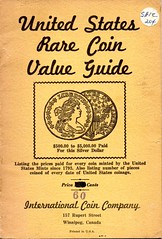 I attach some pages from a Canadian coin guide bought at a local coin club this week.
It dates from 1959/60 and gives their buying prices. My question is could these prices have been realistic at that time?
They seem very low – Pine Tree sixpence 5 dollars!
I attach some pages from a Canadian coin guide bought at a local coin club this week.
It dates from 1959/60 and gives their buying prices. My question is could these prices have been realistic at that time?
They seem very low – Pine Tree sixpence 5 dollars!
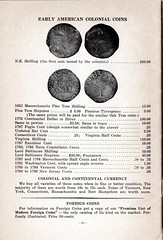
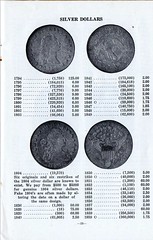
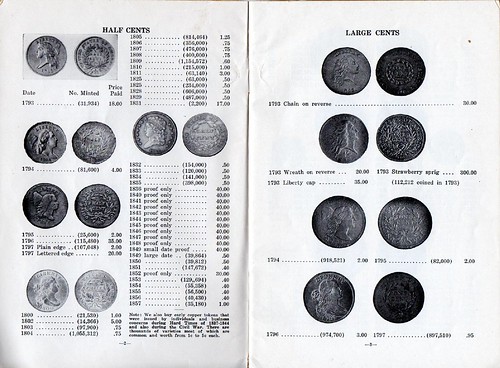
To read the complete article, see: ()
FAKE SILVER BARS OFFERED ON EBAY
Dick Hanscom writes:
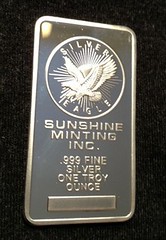 The plated or clad bars have been on eBay for a while, but I had not noticed one that is blatantly copying a known product.
I have dropped an email to Sunshine, but they have probably seen them.
The plated or clad bars have been on eBay for a while, but I had not noticed one that is blatantly copying a known product.
I have dropped an email to Sunshine, but they have probably seen them.
My question is this: Where is our government, who protected us against the "Liberty Dollar," when there are people out there selling products like this? While they state that they are plated, once sold into the market, the level of fraud is unlimited. Many do not say plated or clad on the bar, leaving the next buyer to think they are getting the real thing.
I know we have purchased a couple of items that weren't this good, just by not paying attention.
Can something be done under the hobby protection act? Can ICTA do anything?
To view the complete eBay item, see: 1 TROY OZ .999 FINE SILVER PLATED SUNSHINE MINT EAGLE BULLION BAR Proof Bright! (www.ebay.com/itm/390531451669?ssPageName=STRK:MEWAX:IT&_trksid=p3984)
To contact ICTA, see: www.ictaonline.org
In 2012 there has been an increase in the amount of fake silver hitting the market. A lot of this fake silver seems to be sold through e-bay and other online marketplaces.
Historically silver has been fairly safe to purchase in one ounce weights, as the price of silver has meant that counterfeiting coins and bars has not been worthwhile. However now with the silver price steadily above $30, there is much more incentive for scammers to produce fake coins and bars.
Recently I was duped myself and purchased two 1 oz silver bars through e-bay which turned out to be fake. After this experience I am much more cautious now about where and who I buy silver from. This hub explains some of the risks and precautions that you can take to avoid falling into the same trap as I did of buying fake silver.
To read the complete article, see: Fake Silver Bars and Coins - Buyer Beware! (theeyeballkid.hubpages.com/hub/Fake-silver-bars-and-coins)
THE PCGS COIN SNIFFER
 On the PCGS Message Boards Coin Forum (www.pcgs.com) Saturday, I spotted a segment dated 2/9 7:07 pm (for those trying to locate it) concerning PCGS Coin Sniffer and watched the video on it. About eight minutes long, it is extremely well done and very educational and revealing. It concerns PCGS' new capacity to electronically discern any questionable foreign substance on a coin submitted for authentication or grading and thereby consider it "doctored".
On the PCGS Message Boards Coin Forum (www.pcgs.com) Saturday, I spotted a segment dated 2/9 7:07 pm (for those trying to locate it) concerning PCGS Coin Sniffer and watched the video on it. About eight minutes long, it is extremely well done and very educational and revealing. It concerns PCGS' new capacity to electronically discern any questionable foreign substance on a coin submitted for authentication or grading and thereby consider it "doctored".
Including - and shown in close-up on the video - are substances that would disqualify a coin as "doctored" such as Blue Ribbon (formerly known as Care), sulfur paste, beeswax and mineral oil - harmless substances that have been used for many decades, in some cases well over a century - on primarily early coppers: colonials, large and half cents. Used not to hide or doctor or conceal defects but to preserve surfaces from oxidation and contaminants like spittle or to darken rubbed-raw bright red high relief areas, or to smooth out pock -marked areas with beeswax (the latter a common practice back in the 19th century) .
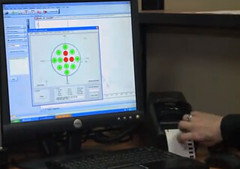

Now, recently major collections of large cents like Walt Husak, Dan Holmes and Paul Gerrie have had many if not all their early dates at one time or another treated with a very light coating of either Blue Ribbon or the older Care. Indeed, not to do that would have been ill-advised. Most of these coins were slabbed by NGC or PCGS. It is simply almost universal practice to use Care or Blue Ribbon on an early copper, removing perhaps 99% of the substance with a soft blotting cloth...but certainly enough to be discerned by the new "sniffing" device explained and shown in operation in the PCGS "sniffer" video. The same can be said for the use of "Dellers Darkener" sulfur paste on selected coins with a slightly "rubbed raw" relief or a harshly cleaned early copper.
I had written "almost all" the early dates in the collections were Care'd or Blue Ribbon'd at one time. In fact, it would apply to every single early date...I used to watch Walt Husak, a good friend, do it to his early coppers and I do it to mine. It is not a common practice on later date blazing mint red dates and is in fact discouraged as Care/Blue Ribbon tones down blazing mint red.
Many early copper collectors use a "camel's hair" brush on their early coppers (Ted Naftzger did, Doug Bird does) and those often quite well-used brushes always have so-called "contaminants" soaked on / embedded in their bristles which could also trigger the PCGS "sniffer".
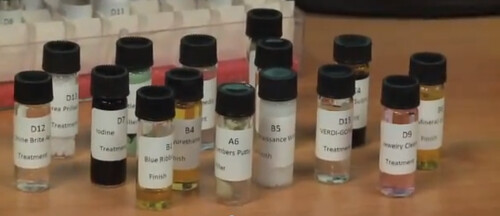
So does this mean that all currently slabbed early date coppers and those likely yet to be slabbed will not slab now other than as "doctored" or will slab again in the future as "doctored" if Care or Blue Ribbon or sulfur paste has been ever applied as a long-acceptable practice in numismatics?
The "doctored" appellation should apply exclusively to defects concealed by a process in an attempt to increase value and deceive a buyer, not to merely preserve condition.
To view the Coin Sniffer video, see: Secure Plus Update II - Coin Sniffer (www.youtube.com/watch?v=mA3nZeADTBg)
To read the PCGS Forum thread, see: forums.collectors.com/messageview.cfm?catid=26&threadid=880389
THE BOOK BAZARRE
HARVEY STACK ON MEETING COL. E.H.R. GREEN
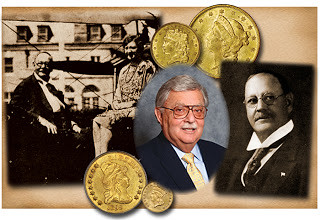
Alan V. Weinberg writes:
I've read many of Harvey Stack's reminiscences before , some in the process of editing them. But his current story on Col Green in 1936 was fascinating and, I believe, not previously revealed.
In 1936, during one of the Saturdays I had off from school, I was working at our shop on 6th Avenue (currently called 'The Avenue of the Americas”). I was amazed to see a large Rolls Royce, chauffeur driven, stop in front of our shop. The chauffeur got out and quickly opened the door where the passenger was sitting. The car had a very high ceiling, (had to be custom built) and the passenger got out. He was a very tall man, about 6 feet 4 inches tall, and quite large (I learned later that he weighed close to 300 pounds). He was immaculately dressed, with a high hat on his head, and walked with the help of a cane.
My seniors told me that Col. E.H.R. Green was coming to visit. Col. Green, born as Edward Howland Robinson Green, had a full size cork false leg, but walked upright and smartly. I learned that he had his leg amputated after a severe infection when he was a young man. He was the son of the famous woman financer, Hetty Green, probably the richest lady in America (during her lifetime). She was so strict and demanding that she had the title of “ the Witch of Wall Street.” She dressed in very provincial black dresses, and frightened all who dealt with her. At the time of her death in 1916 she was said to be worth well over $100 million and probably much more -- those millions were like today’s billions.
So this was the man who was visiting our shop. My father and uncle greeted him, and when he saw me, he asked "who this may be?" My father responded, "He is my son Harvey who is here helping us out and trying to learn the numismatic business." Col. Green shook my hand and said, "My boy, you are lucky to have two teachers like your father and uncle. " "Now," he said, "what do you have for me to look at?" This was his usual greeting and the family was prepared, as usual to serve him. Since Col. Green visited our shop about twice a month, my family set aside new acquisitions and had them displayed in large wooden trays, careful marked and priced to show him what they had assembled.
Col. Green took out a large magnifier and carefully examined each coin. He remarked on those that he thought were beautiful and knew which might be rare and unusual. Whether they were coins of the United States or the rest of the world, he knew about them and commented as he examined the trays. That day there were five trays, each containing 15 or 20 coins. He would count each early $5 and $10 gold, along with the other coins. When he was through he would look up at my father and uncle who were nearby and would ask, "How much do you want for all five trays?"
As this wasn't the first time he had visited, the Stack brothers were prepared to quote a price for the lot. Col. Green, gave the group one more quick look and said "I will take them all." He then turned to the door and summoned in his driver, who came over, picked up the five trays, carried them out of the shop and placed them in the trunk of the waiting Rolls Royce. Col. Green got up, turned to me, said goodbye, then turned to my uncle and father and repeated his “thank you and goodbyes,” and went directly to his car, was helped in by his driver and off he went.
On the following Monday, shortly after the shop opened for business Col. Green’s chauffeur returned with the empty trays and a check for the purchase. The Stack brothers started again that morning to assemble another group for a possible next sale. It was understood that he visited stamp dealers, antique dealers and jewelers in a similar manner. If he liked it he bought it. He also had a fetish for cars, all models and makes, and enjoyed unusual models and designs. He loved to drive them as well, and had them fitted in a special manner so he could drive using his one good leg.
Col. Green, in collecting and hoarding rare gold coins especially early $5 and $10 gold kept many from the melting pot, for he had the funds to buy and hold them. He died in 1936, and the Chase Bank in New York was his executor. Because there was a major lawsuit between his wife (he married late in life) and his sister as to who should benefit from his treasures, his coin collection and stamp collection were not dispersed till the 1940s since there wasn't a buyer or group available to buy the quantities he had assembled.
For example, his $5 and $10 gold were first marketed in 1943 and Stack’s bought them and little else. The cost was high at the time, the market for buyers was small, and many of the coins had to be held for years in order to sell them in orderly fashion. How Stack’s did this is another story which included selling to King Farouk of Egypt, Clifford T. Weihman, James Stack, Gaston DiBello, and J.J. Pittman to mention a few.
The lessons I learned from meeting people and seeing how to deal with them guide me to this very day. Colonel Green was a person one can never forget!
Alan adds:
Imagine, the Col. died the very year he was in the practice of reviewing and taking home "on approval" a fortune in rare coins, etc. without so much as a check or paying up front! That could have been a minor financial catastrophe, given the period.
To read the complete article, see: Remember When: 1954 – The First Time I Met Col. E.H.R. Green (stacksbowers.com/Blogs/remember-when-1954-first-time-i-met-col.html)
FRANKLIN'S 1776 VISION FOR AMERICA'S GREAT SEAL

Benjamin Franklin's Great Seal Design
In the story of America's Great Seal, a particularly relevant chapter is the imagery suggested by Benjamin Franklin in August 1776. He chose the dramatic historical scene described in Exodus, where people confronted a tyrant in order to gain their freedom.
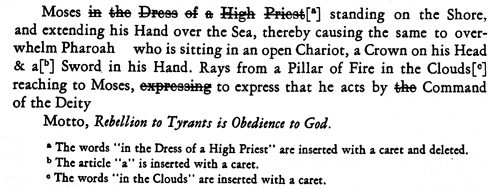
Transcription of Franklin's Great Seal design
Franklin's design was recommended by the first committee for the reverse side of the Great Seal. No sketch was made of their design. The above drawing was made by Benson J. Lossing for Harper's New Monthly Magazine in July 1856. Note: Lossing failed to include something Franklin specified: "Rays from a Pillar of Fire in the Clouds reaching to Moses.
A full-color realization has been created of Ben Franklin's design. The new painting by surrealistic artist Robin Heslop is based solely on Franklin's written description. The result is strikingly original.
To read the complete article, see: Benjamin Franklin's Great Seal Design (ww.greatseal.com/committees/firstcomm/reverse.html)
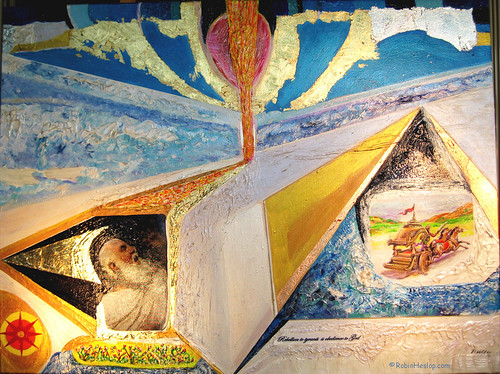
From Robin Heslop's web page:
Emigrating from England to the USA in the late 1970s – followed by my Naturalization and swearing in ceremony in Miami on August 1, 1989 – had made me abundantly aware that Benjamin Franklin was the most powerful writer of his time, as well as a famous scientist, statesman, philosopher, businessman, and civic leader.
It was an important step in the naturalization process that the entire history of the Declaration of Independence of 1776 be known to me in detail. I enjoyed reading many history books as well as Franklin's essays, articles, bagatelles, letters, Poor Richard's Almanack, and Autobiography.
You could say I felt that Ben Franklin had now become one of my cherished Spirit Guides. So when in early 2011, my friend John MacArthur sent me Ben Franklin's description of his design for the Great Seal, I enthusiastically agreed to create a new and entirely original composition in acrylic paint on stretched canvas embellished by gold, silver and copper leaf.
To read the complete article, see: "Rebellion to Tyrants is Obedience to God" (www.acrylicvisions.com/pyramids/moses.html)
STATE LAWMAKERS PRESSING CASE FOR MAKING OWN MONEY
A growing number of states are seeking shiny new currencies made of silver and gold.
Worried that the Federal Reserve and the U.S. dollar are on the brink of collapse, lawmakers from 13 states, including Minnesota, Tennessee, Iowa, South Carolina and Georgia, are seeking approval from their state governments to either issue their own alternative currency or explore it as an option. Just three years ago, only three states had similar proposals in place.
"In the event of hyperinflation, depression, or other economic calamity related to the breakdown of the Federal Reserve System ... the State's governmental finances and private economy will be thrown into chaos," said North Carolina Republican Representative Glen Bradley in a currency bill he introduced last year.
Unlike individual communities, which are allowed to create their own currency -- as long as it is easily distinguishable from U.S. dollars -- the Constitution bans states from printing their own paper money or issuing their own currency. But it allows the states to make "gold and silver Coin a Tender in Payment of Debts."
To read the complete article, see: States seek currencies made of silver and gold (money.cnn.com/2012/02/03/pf/states_currencies/)
John and Nancy Wilson forwarded this article on the Virginia proposal:
Virginia advances bill pushing for state to establish its own currency
(www.foxnews.com/politics/2013/02/06/virginia-is-one-step-closer-to
-returning-to-gold-standard/)
Virginia Del. Robert G. Marshall fears that a financial apocalypse is coming and only one thing can save the Commonwealth: its own currency.
The idea that Virginia should consider issuing its own money was dismissed as just another quixotic quest by one of the most conservative members of the state legislature when Marshall introduced it three years ago. But it has since gained traction not only in Virginia, but also in states across the country as Americans have grown increasingly suspicious of the institutions entrusted with safeguarding the economy.
This week, the proposal by the Prince William Republican sailed through the House of Delegates with a two-to-one majority.
“This is a serious study about a serious topic,” Marshall said Tuesday. “We’re not completely powerless.”
So far, only Utah has approved a law recognizing nontraditional currency. Four other states have bills pending this year. Marshall said he is unsure of his proposal’s prospects in the Virginia Senate. One Democrat derided it as a descent into “la-la land.”
To read the complete article, see:
Virginia coin moves closer to reality
(www.washingtonpost.com/business/economy/virginia-coin-moves-closer
-to-reality/2013/02/05/9bcdd532-6fa4-11e2-ac36-3d8d9dcaa2e2_story.html)
A Tennessee maintenance worker says he quit his job because his W-2 tax form was stamped with the number 666.
Walter Slonopas told The Tennessean that accepting the number would have condemned his soul to hell. That number is considered the “mark of the beast” in the Bible’s Book of Revelation describing the apocalypse.
The company that handles payroll for Contech Casting LLC says the number meant Slonopas’ form was the 666th one mailed out
To read the complete article, see:
Tenn. man quits job after finding ‘666’ stamped on W-2 form, says God is worth more than money
(www.washingtonpost.com/business/tenn-man-quits-job-after-finding
-666-stamped-on-w-2-form-says-god-is-worth-more-than-money
/2013/02/07/807077b8-715c-11e2-b3f3-b263d708ca37_story.html)
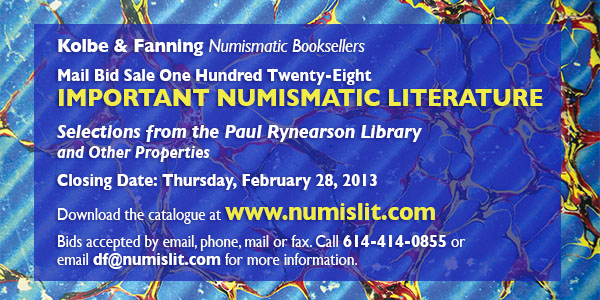
AMAZON TO DEBUT "AMAZON COINS"
 When I heard about Amazon Coins, the company's virtual currency for making Kindle Fire app and in-app purchases starting in May, I immediately grew worried.
Amazon's customer focus, something I find sorely absent at money-extraction engines such as airlines and banks, has kept me loyal for years. I'm concerned, though, that the Amazon Coins program is a step in the wrong direction for Amazon customers.
When I heard about Amazon Coins, the company's virtual currency for making Kindle Fire app and in-app purchases starting in May, I immediately grew worried.
Amazon's customer focus, something I find sorely absent at money-extraction engines such as airlines and banks, has kept me loyal for years. I'm concerned, though, that the Amazon Coins program is a step in the wrong direction for Amazon customers.
In short, I don't like the inflexibility, costs, changeable rules, and risks that can be attached to virtual currency. I dislike it when there's a special form of money that works only in a limited marketplace, and I dislike it even more when the company operating the marketplace sets the rules for using that currency.
Amazon isn't yet sharing details or answering my questions, so this isn't a final judgement. I'm willing to be persuaded if Amazon's virtual coins are useful and beneficial and if Amazon runs the program sensibly. But my experiences with this idea so far make me leery.
My biggest concern is that Amazon Coins are a way to suck me and my money into the Amazon financial ecosystem and to make it hard for me and my money to leave.
Amazon's coins fundamentally are less flexible than real money, with which I can buy haircuts, groceries, and mutual funds. Amazon's coins remind me too much of company scrip, which mining and timber companies used instead of cash to pay employees. Scrip could only be used at the company store, the economically wicked institution immortalized in the song "Sixteen Tons." With real money, people can spend it where they see fit.
Maybe Amazon Coins will remain in a tiny app-store corner of the company's commercial transactions. But the possibility that they could spread so much farther makes them much more important than other virtual currencies and means we should pay much closer attention to what Amazon does with them.
Anytime somebody tries to persuade you to use their own special form of money, ask yourself why it's worth sacrificing the flexibility of real-world currency. Maybe it's something benign -- lower transaction costs or commerce friction, for example, which can lead to a more vibrant or efficient marketplace.
But especially when Amazon says it "will give customers tens of millions of dollars' worth of free...coins to spend," be very careful.
There's no such thing as a free lunch, and there's no such thing as a free Amazon coin, either.
To read the complete article, see: Why Amazon's virtual coins raise my hackles (news.cnet.com/8301-1023_3-57568116-93/why-amazons-virtual-coins-raise-my-hackles/)
BANK NOTE PRINTER DE LA RUE CELEBRATES ITS BICENTENNIAL
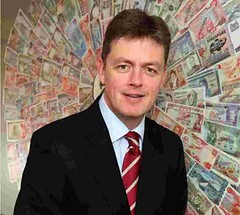 THE world's leading bank note maker De La Rue is celebrating its 200 th birthday today.
THE world's leading bank note maker De La Rue is celebrating its 200 th birthday today.
It was founded by Thomas de la Rue in Guernsey on February 6, 1813.
Now De La Rue is headquartered in Basingstoke and is the trusted partner of governments, central banks, issuing authorities and commercial organisations operating in over 150 countries across the world.
De La Rue’s chief executive officer Tim Cobbold said: “For any company to reach its 200 th anniversary is a significant achievement and we are particularly grateful to all the customers that have supported us over the past 200 years.
“De La Rue has a long history of innovation and as a part of continuing this rich tradition I was delighted that in December we launched the first De La Rue polymer banknote for Fiji, which is due to go into circulation in March.”
This latest innovation is one of many that the that the company has produced over the past 200 years.
Back in 1831 it registered the ace of spades playing card produced using a revolutionary new typographical process ensuring uniformity in card manufacturing.
It was subsequently granted a royal patent by William IV to print playing cards that had previously been produced by hand using stencils.
In 1840 De La Rue produced its first adhesive postage stamp and in 1846 registered its patent for the first envelope folding machine.
De La Rue secured its first contract to print banknotes with the Bank of Mauritius in 1860 for the Mauritius 10 shilling, £1 and £5 notes.
This was the start of a longstanding partnership with the Bank of Mauritius which is still going strong 150 years later.
In 1914, De La Rue was commissioned to produce the £1 and one shilling notes for the Bank of England – the start of another important collaboration with the Bank that continues today.
However, De La Rue’s subsidiary, Portals Limited, first produced currency paper for the Bank of England in 1724.
By 1947 the group was operating in over 60 countries worldwide and was listed on the London Stock Exchange.
For bibliophiles, I should note that there was a history of De La Rue published in its 150th anniversary in 1963: The World of De La Rue. The Old World and the New presented on the occasion of the One Hundred and Fiftieth Anniversary of The House of De la Rue 1813-1963. Will there be a new edition for their 200th? -Editor
To read the complete article, see:
Bank note printer De La Rue, headquartered in Basingstoke, celebrates its 200th anniversary today
(www.basingstokegazette.co.uk/business/10208766.Bank_note_printer
_De_La_Rue_celebrates_its_200th_anniversary_today/)
THE BOOK BAZARRE
VIDEO: TRIAL OF THE PYX AT LONDON'S GOLDSMITHS’ HALL
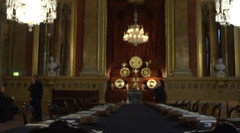 A 1kg gold coin struck to commemorate the London Olympics was just one of the new coins put through its paces, as the Goldsmiths Company opened their doors to the Telegraph to witness the ancient 'Trial of the Pyx'.
A 1kg gold coin struck to commemorate the London Olympics was just one of the new coins put through its paces, as the Goldsmiths Company opened their doors to the Telegraph to witness the ancient 'Trial of the Pyx'.
"The one kilo coin is a new addition to the UK coinage. It came through legislation in 2012 and it's a gold alloy and there's a silver demonination as well," said Gwyn Roberts, head of quality assurance at the Royal Mint. "They are then marketed and bought by private coin collectors."
The gold kilo coin was amongst the coins being examined on Tuesday at the ‘Trial of the Pyx’, an ancient ceremony to test the integrity of new coins produced by the Royal Mint.
The ceremony takes place each year at the Goldsmiths’ Hall in the City of London, which is the home of the Goldsmiths livery company.
Steeped in history, the Trial of the Pyx – which is Latin for chest - dates back to the 13th century and is one of Britain’s longest-established judicial procedures.
The three-stage trial involves a jury of goldsmiths counting and weighing a selection of new coins.
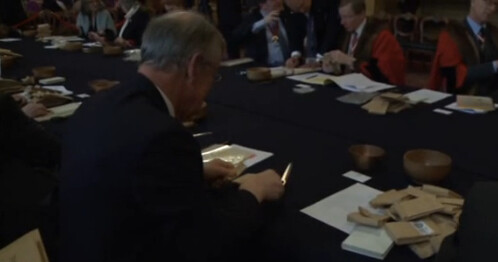
These coins are then tested by the Goldsmiths’ Assay Office and two months later a verdict is delivered on whether the coins meet the required standard.
"It would be easy to say this is no longer relevant anymore when money is created electronically," said Nick Harland, deputy clerk of the Goldsmiths' Company.
"But in fact this sort of assessment once a year does maintain the standards of the Royal Mint. The cachet which they get from being held up to the very highest standards here is something they can trade on out in the greater world."
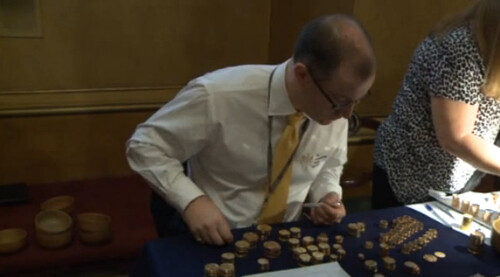
To read the complete article, see:
Trial of the Pyx: Goldsmiths put the nation's coins through their paces
(www.telegraph.co.uk/finance/currency/9851289/Trial-of-the-Pyx-
Goldsmiths-put-the-nations-coins-through-their-paces.html)
CANADA BEGINS ITS CENT PHASE-OUT
Canada has begun phasing-out its penny, whose production costs have come to exceed its monetary value.
The Royal Canadian Mint on Monday officially ended its distribution of one-cent coins to financial institutions.
While people may still use pennies, the government has issued guidelines urging store owners to start rounding prices to the nearest nickel for cash transactions. Electronic purchases will still be billed to the nearest cent.
The government has said the cost of penny production is $11 million a year, and that the coins, which feature two maple leaves and Queen Elizabeth II in profile, would remain legal tender until they eventually disappeared from circulation.
Google is marking the passing of the penny with a dedicated doodle on its Canadian home page.
New Zealand, Australia, the Netherlands, Norway, Finland, Sweden and others have also dropped the penny.
The U.S. Treasury Department has said the Obama administration has looked at possibly using cheaper materials to make the penny, which is now made of zinc.
To read the complete article, see: In Canada, the phase out of the penny begins (libn.com/2013/02/06/in-canada-the-phase-out-of-the-penny-begins/)
FEATURED WEB PAGE: THE GREAT SEAL
This week's Featured Web Page is all about the Great Seal of the United States.
Designed by some of the nation's most visionary Founders, the two sides of the Great Seal embody the essential guiding principles these farsighted patriots hoped we would always follow.
The actual Great Seal adopted by Congress on June 20, 1782 is a written document that precisely describes the imagery.
For the past 230 years, the U.S. Department of State has been sealing official documents using engraved dies based on this official description. The first die is shown here. (Note: the design is in reverse.) The government also has official illustrations of the Great Seal's two sides.
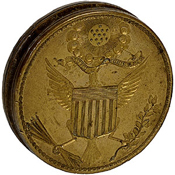
www.greatseal.com

